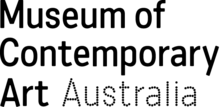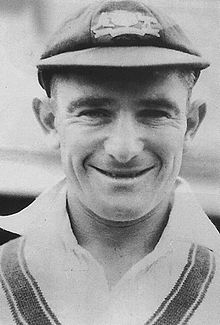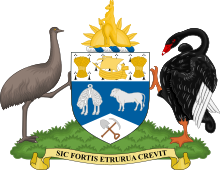Portal:New South Wales
The New South Wales Portal


New South Wales (commonly abbreviated as NSW) is a state on the east coast of Australia. It borders Queensland to the north, Victoria to the south, and South Australia to the west. Its coast borders the Coral and Tasman Seas to the east. The Australian Capital Territory and Jervis Bay Territory are enclaves within the state. New South Wales' state capital is Sydney, which is also Australia's most populous city. , the population of New South Wales was over 8.3 million, making it Australia's most populous state. Almost two-thirds of the state's population, 5.3 million, live in the Greater Sydney area.
The Colony of New South Wales was founded as a British penal colony in 1788. It originally comprised more than half of the Australian mainland with its western boundary set at 129th meridian east in 1825. The colony then also included the island territories of Van Diemen's Land, Lord Howe Island, and Norfolk Island. During the 19th century, most of the colony's area was detached to form separate British colonies that eventually became the various states and territories of Australia and, arguably, New Zealand. The Swan River Colony (later called the Colony of Western Australia) was never administered as part of New South Wales. (Full article...)
-

William Alfred Brown, OAM (31 July 1912 – 16 March 2008) was an Australian cricketer who played 22 Test matches between 1934 and 1948, captaining his country in one Test. A right-handed opening batsman, his partnership with Jack Fingleton in the 1930s is regarded as one of the finest in Australian Test history. After the interruption of World War II, Brown was a member of the team dubbed "The Invincibles", who toured England in 1948 without defeat under the leadership of Don Bradman. In a match in November 1947, Brown was the unwitting victim of the first instance of "Mankading".
Raised in New South Wales, Brown initially struggled in both work and cricket, before gradually rising through the cricket ranks. He made his first-class debut for New South Wales in the 1932–33 season and forced his way into the national side during the 1934 tour of England. When long-term openers Bill Ponsford and Bill Woodfull retired at the end of the tour, Brown and his state opening partner Fingleton took over. After poor form made his selection for the 1938 tour of England controversial, Brown responded with a total of 1,854 runs, including an unbeaten 206 that saved Australia from defeat in the Second Test, and was honoured as one of the five Wisden Cricketers of the Year. (Full article...) -
St John the Baptist Anglican Church is an active Anglican church located between Alt and Bland Streets, Ashfield, a suburb of Sydney, New South Wales, Australia. Founded in 1840, on land donated by Elizabeth Underwood, the church building is the oldest authenticated surviving building in Ashfield, having been built at the time when subdivision increased the population density sufficiently to turn Ashfield into a town. It was also the first church built along the Parramatta Road which linked the early colonial towns of Sydney and Parramatta. The earliest remaining parts of the building are one of the first Sydney designs by the colonial architect Edmund Blacket, who later became renowned for his ecclesiastical architecture.
The expansive church grounds contain a cemetery dating back to 1845 that contains the remains of many notable Ashfield residents. Australia's only memorial to Australian Air Force Cadets occupies a prominent position near the entrance to the church. The St John's site has been listed on the Local Environment Plan Heritage Schedule, and the Register of the National Trust of Australia. (Full article...) -
The Museum of Contemporary Art Australia (MCA), formerly the Museum of Contemporary Art, Sydney, is located on George Street in The Rocks neighbourhood of Sydney. The museum is housed in the Stripped Classical/Art Deco-styled former Maritime Services Board (MSB) building on the western side of Circular Quay. A modern wing was added in 2012.
While the museum as an institution was established in 1991, its roots go back a half-century earlier. Expatriate Australian artist JW Power provided for a museum of contemporary art to be established in Sydney in his 1943 will, bequeathing both money and works from his collection to the University of Sydney, his alma mater. The works, along with others acquired with the money, were exhibited mainly as a travelling collection in the decades afterward, stored in two different university buildings. This collection was known as the Power Gallery of Contemporary Art. (Full article...) -
Maddison Gae Elliott, OAM (born 3 November 1998) is an Australian swimmer. At the 2012 Summer Paralympics in London, she became the youngest Australian Paralympic medallist by winning bronze medals in the women's 400 m and 100 m freestyle S8 events. She then became the youngest Australian gold medallist when she was a member of the women's 4 × 100 m freestyle relay 34 points team. At the 2016 Rio Paralympics, she won three gold and two silver medals. (Full article...) -
Hannah Dodd (born 27 April 1992) is an Australian Grade IV equestrian and 1.0 point wheelchair basketball player who represented Australia in equestrian at the 2012 Summer Paralympics in London, coming 11th and 12th in her events. Switching to wheelchair basketball, she made her debut with the national team at the Osaka Cup in February 2015.
In 2008, Dodd was the Australian national Grade IV para-equestrian champion. She was runner-up in 2009, and won the Australian national championships again in 2011, along with the Oceania Championships and the National Titles team events. By 2012, she was the top-ranked Australian competitor in her event and class. (Full article...) -
Edward Davis Millen (7 November 1860 – 14 September 1923) was an Australian journalist and politician who served as the first Minister for Repatriation.
Millen emigrated to Australia from England around 1880 and established himself as a journalist, subsequently serving in the New South Wales Legislative Assembly from 1894 to 1898, during which time he fiercely opposed the proposed Federation despite supporting the principle. He was a member of the New South Wales Legislative Council from 1899 until his election to the Australian Senate as a Free Trader from New South Wales at the first federal election in 1901. Millen led the conservative parties in the Senate from 1907 until shortly before his death in 1923. (Full article...) -
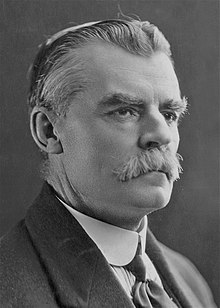
Matthew Charlton (15 March 1866 – 8 December 1948) was an Australian politician who served as leader of the Australian Labor Party (ALP) and Leader of the Opposition from 1922 to 1928. He led the party to defeat at the 1922 and 1925 federal elections.
Charlton was born in Linton, Victoria, but as a child moved to Lambton, New South Wales. He left school at a young age to work in the coal mines, initially as a hurrier. Charlton became prominent in the trade union movement, and in 1903 was elected to the New South Wales Legislative Assembly for the Labor Party. He switched to federal parliament in 1910. Charlton was an anti-conscriptionist, and remained with Labor after the party split of 1916. He was elected party leader in early 1922, following the death of Frank Tudor. He increased Labor's vote at the 1922 election but suffered a backwards slide in 1925. He resigned as leader in early 1928, succeeded by James Scullin, and left politics later that year. (Full article...) -

The Eastern Suburbs & Illawarra Line (numbered T4, coloured azure blue) is a commuter railway line on the Sydney Trains network in the eastern and southern suburbs of Sydney. The line was constructed in the 1880s to Wollongong to take advantage of agricultural and mining potentials in the Illawarra area. In March 1926, it became the first railway in New South Wales to run electric train services.
Today, the railway consists of three connected lines:- The original Illawarra line from the Sydney CBD to Waterfall
- The Cronulla line from Sutherland to Cronulla, which opened in 1939 replacing an earlier tram service
- The Eastern Suburbs line from the Sydney CBD to Bondi Junction, which opened in 1979
-
Charles Hercules Green DSO (26 December 1919 – 1 November 1950) was an Australian military officer who was the youngest Australian Army infantry battalion commander during World War II. He went on to command the 3rd Battalion, Royal Australian Regiment (3 RAR), during the Korean War, where he died of wounds. He remains the only commanding officer of a Royal Australian Regiment battalion to die on active service. Green joined the part-time Militia in 1936, and before the outbreak of World War II had been commissioned as a lieutenant. He volunteered for overseas service soon after the war began in September 1939, and served in the Middle East and the Battle of Greece with the 2/2nd Battalion. After the action at Pineios Gorge on 18 April 1941, Green became separated from the main body of the battalion, and made his way through Turkey to Palestine, to rejoin the reformed 2/2nd Battalion. The 2/2nd Battalion returned to Australia in August 1942 via Ceylon (modern Sri Lanka), to meet the threat posed by the Japanese.
Green performed instructional duties and attended courses until July 1943 when he rejoined the 2/2nd Battalion as its second-in-command. At the time, the unit was training in Queensland. From March to July 1945, Green commanded the 2/11th Battalion during the Aitape-Wewak campaign in New Guinea. For his performance during the campaign, Green was appointed a Companion of the Distinguished Service Order. After the war, Green briefly returned to civilian life and part-time military service as commanding officer of the 41st Battalion. When the Regular Army was formed, Green returned to full-time service in early 1949. (Full article...) -
Sidney George Barnes (5 June 1916 – 16 December 1973) was an Australian cricketer and cricket writer, who played 13 Test matches between 1938 and 1948. Able to open the innings or bat down the order, Barnes was regarded as one of Australia's finest batsmen in the period immediately following World War II. He helped create an enduring record when scoring 234 in the second Test against England at Sydney in December 1946; exactly the same score as his captain, Don Bradman, in the process setting a world-record 405-run fifth wicket partnership. Barnes averaged 63.05 over 19 innings in a career that, like those of most of his contemporaries, was interrupted by World War II.
He made his first-class debut at the end of the 1936–37 season when selected for New South Wales, and he was later included in the team for the 1938 Australian tour of England, making his Test debut in the final international of the series. On the resumption of Test cricket after the war, he was picked as the opening partner to Arthur Morris. Barnes was a member of The Invincibles, the 1948 Australian team that toured England without losing a single match. Retiring from cricket at the end of that tour, Barnes attempted a comeback to Test cricket in the 1951–52 season that was ultimately and controversially unsuccessful. (Full article...) -
Abbotsford Bridge is a steel Allan truss-type road bridge that carries the Silver City Highway across the Murray River, between Curlwaa in New South Wales, and Yelta in Victoria, Australia. It is the only remaining steel truss bridge with a lift span that crosses the Murray. Opened in 1928, the bridge was built by the NSW Department of Public Works and was designed by Percy Allan. It was the second last vertical-lift bridge to be built over the river, the last being the Nyah Bridge, which opened in 1941.
The bridge was constructed over a three-year period from 1925. The project was not originally planned to take as long, but there were delays due to problems with a contractor, and industrial action. The bridge was designed to carry the Mildura railway line over the Murray River and into New South Wales, to service significant cross-border traffic arising from the fruit-growing industry, but the line was never extended beyond the terminus at Yelta. The bridge currently carries a single lane of road controlled by traffic lights. (Full article...) -

Illawarra Steam Navigation Company's SS Bega at Eden in 1903.
The Illawarra Steam Navigation Company was a shipping company that serviced the south coast of New South Wales, Australia from 1858 to the early 1950s. It was formed through the amalgamation of the General Steam Navigation Company, the Kiama Steam Navigation Company and the Shoalhaven Steam Navigation Company, each of whom serviced parts of the south coast with their respective vessels. After merging, the new company held a near monopoly in regard to shipping on the south coast, and their fleet visited every significant port between Sydney and the border of Victoria. The company transported both passengers and a range of produce, including livestock, and hence it became known as the 'Pig and Whistle Line': it was said that ships would wait an hour for a pig but not a minute for a passenger.
Over the years more than twenty steamships were a part of the fleet, including the 1112-ton Merimbula and the 693-ton Eden. Many of these vessels were purpose-built for the company's needs, and were constructed at shipyards both within Australia and abroad. The company's eventual demise came as a result of a number of factors, including increased competition from road and rail, the cost of replacing ships after World War II, waterfront disputes and rising costs. As a consequence, after almost 100 years in operation, the company was placed into voluntary receivership and was delisted from the stock exchange in 1955. (Full article...) -
Library punchbowl showing beach where Circular Quay is now located
The Sydney punchbowls, made in China during the Jiaqing Emperor's reign (1796–1820) over the mid-Qing dynasty, are the only two known examples of Chinese export porcelain hand painted with Sydney scenes and dating from the Macquarie era. The bowls were procured in Canton about three decades after the First Fleet's arrival at Port Jackson where the British settlement at Sydney Cove was established in 1788. They also represent the trading between Australia and China via India at the time. Even though decorated punchbowls were prestigious items used for drinking punch at social gatherings during the 18th and 19th centuries, it is not known who originally commissioned these bowls or what special occasion they were made for.
The punchbowls are a 'harlequin pair', similar but not exactly matching. The bowls have been donated independently, one to the State Library of New South Wales (SLNSW) in 1926 and the other to the Australian National Maritime Museum (ANMM) in 2006. The Library bowl is the more widely known of the pair. Its earliest provenance places it in England in the late 1840s, where it is said to originally have been commissioned for William Bligh; another source suggests Henry Colden Antill. It passed through several owners in Britain before it was presented to the State Library. The Museum bowl's first provenance is from England in 1932 and it has been suggested that it was made to the order of Arthur Phillip. Its whereabouts were unknown until it appeared in the Newark Museum, United States, in 1988, on loan from Peter Frelinghuysen Jr. Through donations, the Maritime Museum later acquired the punchbowl from Frelinghuysen. (Full article...) -
Grevillea juniperina, commonly known as juniper- or juniper-leaf grevillea or prickly spider-flower, is a plant of the family Proteaceae native to eastern New South Wales and southeastern Queensland in Australia. Scottish botanist Robert Brown described the species in 1810, and seven subspecies are recognised. One subspecies, G. j. juniperina, is restricted to Western Sydney and environs and is threatened by loss of habitat and housing development.
A small, prickly-leaved shrub between 0.2–3 m (0.66–9.84 ft) high, G. juniperina generally grows on clay-based or alluvial soils in eucalypt woodland. The flower heads, known as inflorescences, appear from winter to early summer and are red, orange or yellow. Birds visit and pollinate the flowers. Grevillea juniperina plants are killed by bushfire, regenerating afterwards from seed. Grevillea juniperina adapts readily to cultivation and has been important in horticulture as it is the parent of many popular garden hybrids. (Full article...) -

Lambertia formosa, commonly known as mountain devil, is a shrub of the family Proteaceae, endemic to New South Wales, Australia. First described in 1798 by English botanist James Edward Smith, it is the type species of the small genus Lambertia. It is generally found in heathland or open forest, growing in sandstone-based soils. It grows as a multistemmed shrub to around 2 m (7 ft) with a woody base known as a lignotuber, from which it regrows after bushfire. It has stiff narrow leaves, and the pink to red flowerheads, made up of seven individual tubular flowers, generally appear in spring and summer. It gains its common name from the horned woody follicles, which were used to make small devil-figures.
The flowers hold profuse amounts of nectar and are pollinated by honeyeaters. Although L. formosa is uncommon in cultivation, it is straightforward to grow in soils with good drainage and a partly shaded to sunny aspect. It is readily propagated by seed. Unlike all other members of the genus Lambertia, L. formosa is greatly resistant to the soil pathogen Phytophthora cinnamomi. (Full article...)
Selected image

The Sydney Opera House is situated on Bennelong Point in Sydney Harbour, close to the Sydney Harbour Bridge. It is one of the world's most distinctive 20th century buildings, and one of its most famous performing arts venues. It was made a UNESCO World Heritage Site on June 28, 2007.
Related portals
WikiProjects
Selected articles -
-
The Silverton Wind Farm is a 199 megawatt wind farm situated on the Barrier Ranges in New South Wales, built for AGL Energy by Catcon and General Electric.
On 3 June 2009, the project was approved by the Government of New South Wales. (Full article...) -
The University of New South Wales (UNSW), also known as UNSW Sydney, is a public research university based in Sydney, New South Wales, Australia. It is one of the founding members of Group of Eight, a coalition of Australian research-intensive universities. It is ranked 19th in the world (ranked 3rd in Australia) in the 2024 QS World University Rankings.
Established in 1949, UNSW is a research university and a member of Universitas 21, a global network of research universities. It has international exchange and research partnerships with over 200 universities around the world. UNSW is best known in the field of science, technology, engineering, and mathematics (STEM), and ranked highly in both domestic and international university-ranking tables. (Full article...) -
New England is a geographical region in the north of the state of New South Wales, Australia, about 60 km (37 mi) inland from the Tasman Sea. The area includes the Northern Tablelands (or New England Tablelands) and the North West Slopes regions. As of 2021, New England had a population of 185,560, with over a quarter of the people living in the area of Tamworth Regional Council. (Full article...) -
The Central Coast is a peri-urban region lying on the Pacific Ocean in northern-eastern New South Wales, Australia. The region is situated north of Sydney, which is filled with subtropical national parks, forests and also encompasses the major coastal waterways of Brisbane Water, Tuggerah Lakes and southern Lake Macquarie. The region's hinterland, which has fertile valleys, rural farmland and wineries, and also includes the Watagan Mountains. The Central Coast is known for its regional coastal towns like Terrigal, The Entrance, Ettalong Beach, Budgewoi and Bateau Bay with resorts and holiday parks, which feature many expansive beaches and lagoons with surfing and coastal tracks, as well as scenic views. Gosford is the main commercial hub and gateway.
The Central Coast includes major localities, villages and towns such as Gosford, Wyong, Terrigal, Woy Woy and The Entrance. The area is the third-largest urban area in New South Wales and the ninth-largest urban area in Australia. Geographically, the Central Coast is generally considered to include the region bounded by the Hawkesbury River in the south, the Watagan Mountains in the west and the southern end of Lake Macquarie, lying on the Sydney basin. (Full article...) -
Sport in New South Wales describes participation in and attendance at organised sports events in the state of New South Wales in Australia. Sport forms an integral part of the culture of the state.
New South Wales has attracted many international multi-sport events including the 2000 Summer Olympics, held in Sydney. There are many professional sporting teams in New South Wales. The biggest sport in the state by a wide margin is rugby league, in which the state has 10 professional clubs in the National Rugby League. Other popular spectator sports include rugby union, cricket, Australian rules football and soccer. In terms of participation, the most popular sports in the state are netball, tennis, soccer, rugby league and touch football. (Full article...) -
The Sydney Bears (formerly Macquarie Bears) is an Australian semi-professional ice hockey team from Sydney, New South Wales. Established in 1982, the Bears are the only remaining founding member of the Australian Ice Hockey League (AIHL) still operating. The Bears are based at Macquarie Ice Rink, within the Macquarie Centre, in the northern suburbs of Sydney. The Sydney Bears have claimed three Goodall Cups in 2002, 2003 and 2019. (Full article...)
-
Wodonga (pronounced /wəˈdɒŋɡə/; Pallanganmiddang: Wordonga) is a city on the Victorian side of the border with New South Wales, 324 kilometres (201 mi) north-east of Melbourne, Australia. It is part of the twin city of Albury-Wodonga and is located wholly within the boundaries of the City of Wodonga LGA and is separated from its twin city in New South Wales, Albury, by the Murray River. As of 2021 Wodonga and its suburbs have a population of 38,949 and combined with Albury, the two cities form the urban area Albury-Wodonga with a population of 97,793. There are multiple suburbs of Wodonga including Bandiana, Baranduda, Barnawartha, Bonegilla, Ebden, Huon Creek, Killara, Leneva and Staghorn.
Wodonga produces a gross domestic product of $2.5 billion per year on average. (Full article...) -
Kristina Marie Kerscher Keneally (born 19 December 1968) is an American-born Australian politician who served as the first female Premier of New South Wales from 2009 to 2011 and was later a Labor Senator for New South Wales from February 2018 until April 2022. She resigned from the Senate to contest the House of Representatives seat of Fowler, but was unsuccessful. From 2019 to 2022 she served as Deputy Leader of the Opposition in the Senate, Shadow Minister for Home Affairs, and Shadow Minister for Immigration and Citizenship.
Keneally was born in the United States to an American father and an Australian mother. She grew up in Toledo, Ohio, and is a graduate of the University of Dayton. After marrying an Australian, Ben Keneally, she settled in Australia permanently and became a naturalised citizen in 2000. Keneally was elected to the New South Wales Legislative Assembly seat of Heffron at the 2003 state election, succeeding Deirdre Grusovin after a controversial preselection process. After being re-elected to parliament at the 2007 state election, she became the Minister for Ageing and Disability Services and was subsequently appointed Minister for Planning by Premier Nathan Rees in 2008. She was also the state government's spokeswoman for World Youth Day 2008. (Full article...) -
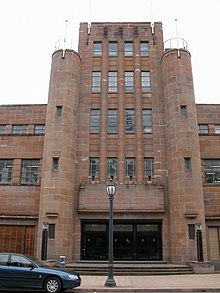
University House is a heritage-listed building in Newcastle in New South Wales, Australia. Located on the corner of King Street and Auckland Street, it was designed by architect Emil Sodersten in association with local architectural practice Pitt and Merewether. An example of Art Deco style, the design was inspired by the streamlined functionalism of contemporary architecture in Europe.
The building was constructed between 1937 and 1939 for the Newcastle Electricity Supply Council Administration and was originally known as N.E.S.C.A House. The interior, designed by Guy Allbut, originally comprised a demonstration theatre, showroom, offices and staff accommodation. In 1959, when Shortland County Council became responsible for electricity supply in the Hunter Region, they constructed a three-storey extension at the back of the building. A tower was added in 1967 and remodelling was carried out in 1969 and 1970. After the council vacated the building in 1987, a radio station and an architectural practice moved in. The building only sustained cosmetic damage during the 1989 Newcastle earthquake. In 1995, the University of Newcastle established a library there. It was added to the New South Wales State Heritage Register on 2 April 1999. (Full article...) -
The Strand Arcade is a heritage-listed Victorian-style retail arcade located at 195–197 Pitt Street in the heart of the Sydney central business district, between Pitt Street Mall and George Street in the City of Sydney local government area of New South Wales, Australia. It was designed by John B. Spencer, assisted by Charles E. Fairfax; and built from 1890 to 1892 by Bignell and Clark (1891), with renovations completed by Stephenson & Turner (1976). The only remaining arcade of its kind in Sydney, the property was added to the New South Wales State Heritage Register on 13 December 2011.
Being three storeys high, the arcade has the traditional-styled protruding galleries, cedar staircases, tiled floors, cast iron balusters and timber framed shop fronts, under a prominent, tinted glass roof to reduce glare. The arcade contains the preliminary boutiques that characterized the Sydney shopping experience of the 1890s. When the arcade opened in 1892, it was said to be the very latest in shopping centre designs and was described as, "The finest public thoroughfare in the Australian colonies". The arcade has endured two depressions, two World Wars and two major fires. The restored shop fronts are an exact replica of the original internal shopping facades. (Full article...) -
The Kosciuszko National Park (/ˌkɒziˈʌskoʊ/) is a 6,900-square-kilometre (2,700 sq mi) national park and contains mainland Australia's highest peak, Mount Kosciuszko, for which it is named, and Cabramurra, the highest town in Australia. Its borders contain a mix of rugged mountains and wilderness, characterised by an alpine climate, which makes it popular with recreational skiers and bushwalkers.
The park is located in the southeastern corner of New South Wales, 354 km (220 mi) southwest of Sydney, and is contiguous with the Alpine National Park in Victoria to the south, and the Namadgi National Park in the Australian Capital Territory to the northeast. The larger towns of Cooma, Tumut and Jindabyne lie just outside and service the park. (Full article...) -
The Murray River (in South Australia: River Murray) (Ngarrindjeri: Millewa, Yorta Yorta: Dhungala (Tongala)) is a river in Southeastern Australia. It is Australia's longest river at 2,508 km (1,558 mi) extent. Its tributaries include five of the next six longest rivers of Australia (the Murrumbidgee, Darling, Lachlan, Warrego and Paroo Rivers). Together with that of the Murray, the catchments of these rivers form the Murray–Darling basin, which covers about one-seventh the area of Australia. It is widely considered Australia's most important irrigated region.
The Murray rises in the Australian Alps, draining the western side of Australia's highest mountains, then meanders northwest across Australia's inland plains, forming the border between the states of New South Wales and Victoria as it flows into South Australia. From an east–west direction it turns south at Morgan for its final 315 km (196 mi), reaching the eastern edge of Lake Alexandrina, which fluctuates in salinity. The water then flows through several channels around Hindmarsh Island and Mundoo Island. There it is joined by lagoon water from The Coorong to the south-east before emptying into the Great Australian Bight (often referenced on Australian maps as the Southern Ocean) through the Murray Mouth, 10 km (6.2 mi) east of Goolwa South. Despite discharging considerable volumes of water at times, particularly before the advent of large-scale river regulation, the waters at the Murray Mouth are almost invariably slow and shallow. (Full article...) -
The Nightcap National Park is a national park situated within the Nightcap Range in the Northern Rivers region of New South Wales, Australia. The 8,080-hectare (20,000-acre) park was created in April 1983 and is situated 35 kilometres (22 mi) north of Lismore. The park was established following campaigns and blockades against logging at Terania Creek, Grier's Scrub and Mount Nardi between 1979 and 1982. Sections of the Whian Whian state forest were added to it following blockading and campaigning in 1998. The national park is classed by the IUCN World Commission on Protected Areas as Category II and is part of the Shield Volcano Group of the World Heritage Site Gondwana Rainforests of Australia inscribed in 1986 and added to the Australian National Heritage List in 2007. (Full article...) -
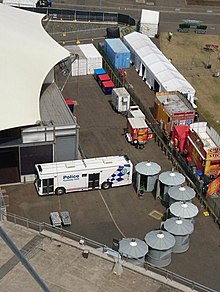
The New South Wales Police Force strip search scandal refers to an ongoing policing scandal surrounding the routine and arbitrary use of strip searches by members of the New South Wales Police Force.
Particular concern has centred around the use of strip searches "in the field", the term used by NSW Police to describe the practice of conducting strip searches outside of a police station. Following the introduction of a controversial law in 2001, police in New South Wales were given the power to deploy specially trained drug detection dogs at large scale public events, licensed venues, and on selected routes across Sydney's public transport network. In 2006, a review published by the New South Wales Ombudsman found that there were significant issues relating to their use, including civil liberties concerns, false positives, and low rates of accuracy. The report noted that during a two-year period between February 2002 and February 2004, NSW Police had conducted 10,211 personal searches resulting from positive drug detection dog indications. Most of those searches had either been a pat down or a search of a person's belongings, however in several cases, officers had made the decision to proceed to a strip search. The Ombudsman noted that such incidents were rare at the time. (Full article...) -
The Bank of New South Wales (BNSW), also known commonly as The Wales, was the first bank in Australia, being established in Sydney in 1817 and situated on Broadway. During the 19th century, the bank opened branches throughout Australia and New Zealand, expanding into Oceania in the 20th century. It merged with many other financial institutions, finally merging with the Commercial Bank of Australia in 1982 and being renamed to the Westpac Banking Corporation on 4 May that year under the Bank of New South Wales (Change of Name) Act 1982. (Full article...)
Did you know (auto-generated)

- ... that Victorian post office official William Rundell also collected stamps in his spare time, acquiring 48 copies of the "Sydney view" stamps of New South Wales?
- ... that Turkish international soccer player Rojin Polat was named member of the "2021 All Schools Merit Girls Team" in New South Wales, Australia?
General images -
-
Humanitarian Caroline Chisholm provided support to poverty-stricken women migrants (from History of New South Wales)
-
World leaders with Prime Minister John Howard in Sydney for the 2007 APEC conference (from History of New South Wales)
-
Founding of the settlement of Port Jackson at Botany Bay in New South Wales in 1788 - Thomas Gosse (from History of New South Wales)
-
A bulk carrier entering the Port of Newcastle, New South Wales, 2009 (from Economy of New South Wales)
-
The 5th Governor of New South Wales, Lachlan Macquarie, was influential in establishing civil society in Australia (from History of New South Wales)
-
William Wentworth was key in the establishment of self-governance in New South Wales (from History of New South Wales)
-
Aboriginal tribes in New South Wales, from an 1892 map (from History of New South Wales)
-
Early expeditions of Charles Sturt (from History of New South Wales)
-
Governor Arthur Phillip hoists the British flag over the new colony at Sydney in 1788 (from History of New South Wales)
-
Köppen climate types in New South Wales (from Geography of New South Wales)
-
Tumut 3 Power Station was constructed as part of the vast Snowy Mountains Scheme in New South Wales (1949–1974). Construction necessitated the expansion of Australia's immigration program. (from History of New South Wales)
-
A 630 lb gold specimen from Hill End, unearthed in 1872 (from History of New South Wales)
-
Mr E.H. Hargraves, The Gold Discoverer of Australia, returning the salute of the gold miners - Thomas Tyrwhitt Balcombe, 1851 (from History of New South Wales)
-
Hyde Park, Sydney with the Australian Museum under construction in the distance, 1842 (from History of New South Wales)
-
Murray Grey cows and calves (from Economy of New South Wales)
-
Bondi Beach circa 1900 (from History of New South Wales)
-
Landing of Lieutenant James Cook at Botany Bay, 29 April 1770 (from History of New South Wales)
-
Ribbon ceremony to open the Sydney Harbour Bridge on 20 March 1932. Breaking protocol, the soon to be dismissed Premier Jack Lang cuts the ribbon while Governor Philip Game looks on. (from History of New South Wales)
-
The Sydney Opera House was opened in 1973. (from History of New South Wales)
-
Federation Pavilion, Centennial Park, Sydney, 1 January 1901. (from History of New South Wales)
-
Dry paddocks in the Riverina region during the 2007 drought (from History of New South Wales)
-
Olympic colours on the Sydney Harbour Bridge in the year 2000 (from History of New South Wales)
-
A General Chart of New Holland including New South Wales & Botany Bay with The Adjacent Countries and New Discovered Lands, published in An Historical Narrative of the Discovery of New Holland and New South Wales, London, Fielding and Stockdale, November 1786 (from History of New South Wales)
-
A chart of part of the interior of New South Wales by John Oxley, Surveyor General, 1822 (from History of New South Wales)
Topics
Categories
More portals
In the news
No recent news
Associated Wikimedia
The following Wikimedia Foundation sister projects provide more on this subject:
-
Commons
Free media repository -
Wikibooks
Free textbooks and manuals -
Wikidata
Free knowledge base -
Wikinews
Free-content news -
Wikiquote
Collection of quotations -
Wikisource
Free-content library -
Wikiversity
Free learning tools -
Wikivoyage
Free travel guide -
Wiktionary
Dictionary and thesaurus




